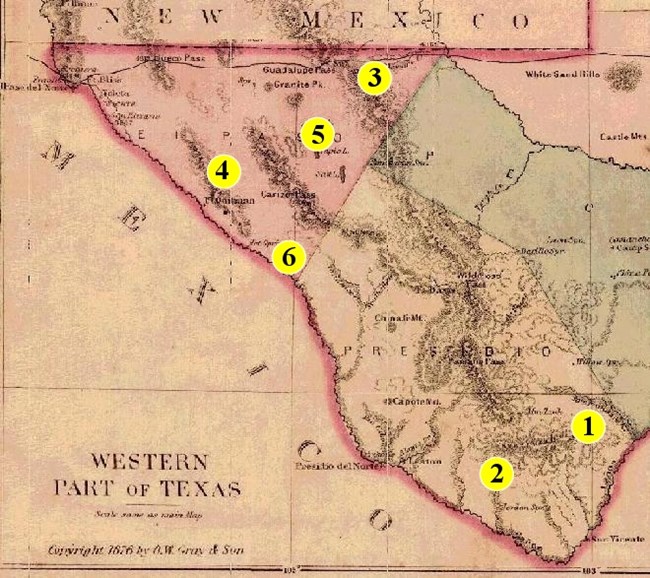
BATTLES & MILITARY ENGAGEMENTS, 1854 - 1981 In August 1861, Mescalero Apaches under Chief Nicolas ran off with the livestock from the post.. An inexperienced Confederate Lieutenant, Reuben Mays, lead a party of six men from Company D, 2nd Texas Mounted Rifles, and seven civilian. They followed the Apaches trail into Big Bend country. Mays partially succeeded in recapturing most of the stolen herd only to fall into a trap in which all of his men perished except for one Mexican guide.
On September 12, 1868, Lieutenant Patrick Cusack with 60 men from Companies C, F, and K, of the 9th Cavalry, and a volunteer party of Mexicans attacked and destroyed a Mescalero village of about 200 Apaches in the Horsehead Hills, 80 miles south of present-day Alpine TX. The Fort Davis troopers had been pursuing Apaches who had attacked and captured livestock from a train near Fort Stockton. Cusack’s Buffalo Soldiers killed 25 Apaches and wounded an additional 25. The soldiers recovered 200 head of stolen cattle, a pony herd, and set free two Mexicans captured by the Apaches.
In January of 1870 Captain Francis S. Dodge of the 9th Cavalry, with a command of 200 men composed of Companies A, C, D, H, I, and K, 9th Cavalry, left Fort Davis, after 160 miles of patroling attacked a Mescalero Apache village near the headwaters of Delaware Creek, one of the most inaccessible regions of the Guadalupe Mountains. Dodge’s attack on January 12, drove the warriors from the villiage. Dodge placed Indian casualties at 10 dead while suffering 2 soldiers killed and 1 wounded. The next day, Dodge destroyed a large quantity of winter supplies, robes, bows, arrows, and ammunition in addition to capturing 25 horses and mules.
On the morning of July 30, 1880, Colonel Benjamin Grierson with just 24 soldiers from the 10th Cavalry occupied a rocky ridge at the east end of Quitman Canyon overlooking the San Antonio - El Paso Road known as Tinaja de Las Palmas. Grierson posted his small force along the rocky outcropping anticipating that Victorio’s Apaches would arrive in search of water. At 9 a.m. Victorio and band of Apaches approached Tinaja de Las Palmas only to be rebuffed by the well-directed fire of Grierson’s troopers. The battle lasted more than four hours with the Apaches finally retreating towards the Rio Grande River when reinforcements of 2 more companies of the 10th cavalry approached the field. Grierson losses were one soldier killed and one officer wounded. He reported killing 7 Indians and wounding many others.
After receiving information that Victorio’s Warm Springs Apaches had crossed the Rio Grande and entered Texas west of present-day Van Horn, Texas, Col. Benjamin Grierson raced to intercept Victorio before he could reach sanctuary in the Guadalupe Mountains. From his supply camp near Van Horn’s Well, Grierson marched 65 miles in less than 21 hours to take up a position at Rattlesnake Springs. On August 6, he concealed two companies of the 10th Cavalry near the water hole and posted two more companies in Rattlesnake Canyon and waited for Victorio to arrive. At 2 p.m., the Indians approached only to be greeted by the carbines of the Buffalo Soldiers. Victorio’s warriors retreated under the attack to the nearby Baylor Mountains, where they observed a military supply train approaching. Victorio attacked the wagons but found it heavily guarded by elements of the 24th Infantry. Thwarted again by the soldiers and unable to reach water, Victorio retreated to Mexico. Grierson reported killing four Apaches while losing no soldiers at Rattlesnake Springs.
On October 26, 1880, a 14-man detachment of the 10th Cavalry marched to Ojo Caliente (Hot Springs), Texas, near old Fort Quitman, for picket duty. The detachment was led by Sergeant Charles Perry of Company B. At daybreak on October 28, the detachment was surprised by a party of 30 - 45 Apaches, probably survivors of Victorio’s Warm Springs Apache, who had been routed only two weeks before by a Mexican army at Tres Castillos. The Apaches approached the soldiers from the Mexican side of the Rio Grande. the warriors killed seven troopers, scattering the rest, and capturing the balance of clothing, arms, horses, and equipment.
|
Last updated: April 23, 2025
